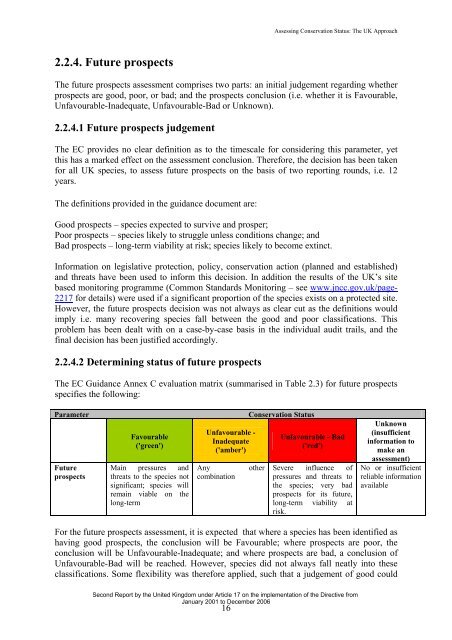Assessing Conservation Status: The UK Approach - JNCC
Assessing Conservation Status: The UK Approach - JNCC
Assessing Conservation Status: The UK Approach - JNCC
You also want an ePaper? Increase the reach of your titles
YUMPU automatically turns print PDFs into web optimized ePapers that Google loves.
<strong>Assessing</strong> <strong>Conservation</strong> <strong>Status</strong>: <strong>The</strong> <strong>UK</strong> <strong>Approach</strong><br />
2.2.4. Future prospects<br />
<strong>The</strong> future prospects assessment comprises two parts: an initial judgement regarding whether<br />
prospects are good, poor, or bad; and the prospects conclusion (i.e. whether it is Favourable,<br />
Unfavourable-Inadequate, Unfavourable-Bad or Unknown).<br />
2.2.4.1 Future prospects judgement<br />
<strong>The</strong> EC provides no clear definition as to the timescale for considering this parameter, yet<br />
this has a marked effect on the assessment conclusion. <strong>The</strong>refore, the decision has been taken<br />
for all <strong>UK</strong> species, to assess future prospects on the basis of two reporting rounds, i.e. 12<br />
years.<br />
<strong>The</strong> definitions provided in the guidance document are:<br />
Good prospects – species expected to survive and prosper;<br />
Poor prospects – species likely to struggle unless conditions change; and<br />
Bad prospects – long-term viability at risk; species likely to become extinct.<br />
Information on legislative protection, policy, conservation action (planned and established)<br />
and threats have been used to inform this decision. In addition the results of the <strong>UK</strong>’s site<br />
based monitoring programme (Common Standards Monitoring – see www.jncc.gov.uk/page-<br />
2217 for details) were used if a significant proportion of the species exists on a protected site.<br />
However, the future prospects decision was not always as clear cut as the definitions would<br />
imply i.e. many recovering species fall between the good and poor classifications. This<br />
problem has been dealt with on a case-by-case basis in the individual audit trails, and the<br />
final decision has been justified accordingly.<br />
2.2.4.2 Determining status of future prospects<br />
<strong>The</strong> EC Guidance Annex C evaluation matrix (summarised in Table 2.3) for future prospects<br />
specifies the following:<br />
Parameter<br />
Future<br />
prospects<br />
Favourable<br />
('green')<br />
Main pressures and<br />
threats to the species not<br />
significant; species will<br />
remain viable on the<br />
long-term<br />
Unfavourable -<br />
Inadequate<br />
('amber')<br />
Any<br />
combination<br />
<strong>Conservation</strong> <strong>Status</strong><br />
other<br />
Unfavourable - Bad<br />
('red')<br />
Severe influence of<br />
pressures and threats to<br />
the species; very bad<br />
prospects for its future,<br />
long-term viability at<br />
risk.<br />
Unknown<br />
(insufficient<br />
information to<br />
make an<br />
assessment)<br />
No or insufficient<br />
reliable information<br />
available<br />
For the future prospects assessment, it is expected that where a species has been identified as<br />
having good prospects, the conclusion will be Favourable; where prospects are poor, the<br />
conclusion will be Unfavourable-Inadequate; and where prospects are bad, a conclusion of<br />
Unfavourable-Bad will be reached. However, species did not always fall neatly into these<br />
classifications. Some flexibility was therefore applied, such that a judgement of good could<br />
Second Report by the United Kingdom under Article 17 on the implementation of the Directive from<br />
January 2001 to December 2006<br />
16
















